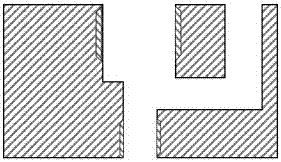In-situ nuclear magnetic resonance test reactor and detection method thereof
A nuclear magnetic resonance and reactor technology, which is used in the analysis of nuclear magnetic resonance, material analysis through resonance, and instruments, etc., can solve problems such as inability to meet experimental conditions, and achieve the effects of low cost, simple operation, and ingenious design.
- Summary
- Abstract
- Description
- Claims
- Application Information
AI Technical Summary
Problems solved by technology
Method used
Image
Examples
specific Embodiment 1
[0042] Specific embodiment 1: study the generation process of hydrogen-containing gas in the solution in the photolysis water reaction process
[0043] Step 1. Catalyst preparation and sample loading preparation
[0044] Appropriate amount of PdCl 2 Aqueous solution was added to the solution containing 100 mg TiO 2 in the crucible, at 80 o Stir and dry under the condition of C; put the crucible in the muffle furnace, with 5 o The rate of C / min raises the temperature of the muffle furnace to 300 o C, treated at constant temperature for 1 h; then, cool down to room temperature naturally, and take out the crucible. Subsequently, the sample was taken out and placed in the quartz ark, and the quartz ark was pushed into the central hot zone of the tube furnace, and the flange was sealed; the hydrogen and argon were measured by the rotameter (hydrogen flow and argon flow than 20 % H 2 / Ar) into the tube furnace after being fully mixed; with 5 o C / min rate to heat up the tube fur...
specific Embodiment 2
[0049] Specific Example 2: Study H 2 O / CD 3 OD and D 2 O / CH 3 Generation of hydrogen-containing gas and intermediate products in OH system
[0050] Pd / TiO 2 The synthesis method of the catalyst is similar to that of Example 1. 2 mg Pd / TiO 2 Catalyst, 20 μL CH 3 OH and 500 μL D 2 O (sample A) and 2 mg Pd / TiO 2 Catalyst, 20 μL H 2 O and 500 μL CD 3 OD (sample B) was added into different NMR tubes, and the ultrasonic dispersion was uniform. Subsequent sample loading preparations are similar to those in Implementation 1.
[0051] Under the condition of shielding from light, carry out in situ on the sample in the in situ NMR reactor 1 H NMR test. The nuclear magnetic resonance instrument in the embodiment is a 700 MHz Agilent nuclear magnetic resonance instrument. Then turn on the xenon light source, and after a certain period of time, the in-situ nuclear magnetic resonance reactor in the liquid 1 H signal is collected. refer to Figure 7 with Figure 8 , against...
PUM
| Property | Measurement | Unit |
|---|---|---|
| diameter | aaaaa | aaaaa |
| diameter | aaaaa | aaaaa |
Abstract
Description
Claims
Application Information
 Login to View More
Login to View More - R&D
- Intellectual Property
- Life Sciences
- Materials
- Tech Scout
- Unparalleled Data Quality
- Higher Quality Content
- 60% Fewer Hallucinations
Browse by: Latest US Patents, China's latest patents, Technical Efficacy Thesaurus, Application Domain, Technology Topic, Popular Technical Reports.
© 2025 PatSnap. All rights reserved.Legal|Privacy policy|Modern Slavery Act Transparency Statement|Sitemap|About US| Contact US: help@patsnap.com



